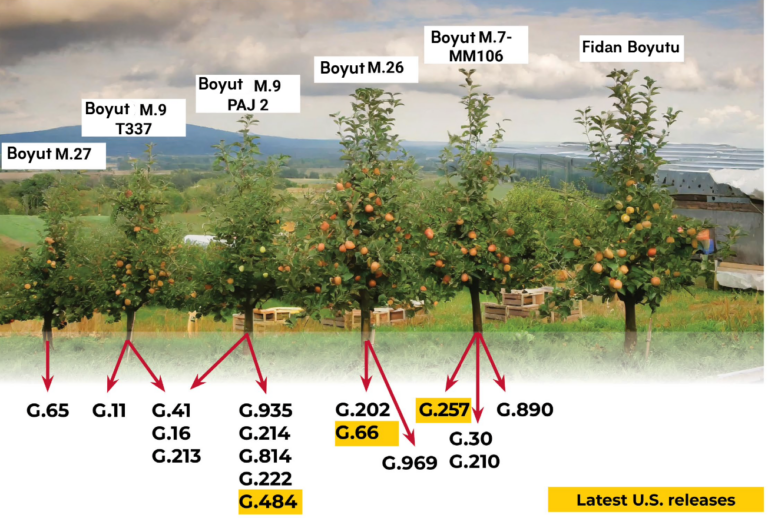Yield Improvement in Dwarf Apple Cultivation with Geneva Apple Rootstocks
Innovations Enhancing Yield and Resistance in Apple Rootstocks
Increased Productivity in Geneva Apple Rootstocks
As a result of extensive trials conducted in various locations around the world—particularly in North America—all Geneva rootstocks released to the market have demonstrated similar or higher “yield per acre” and “yield per tree” compared to existing commercial standards like M.9 and M.26.
Apple Rootstocks and Their Characteristics
- Disease Resistance: Resistant to fire blight, crown and root rots, and replant disorders.
- Pest Resistance: Resistant to woolly apple aphid.
- Other Features: All rootstocks are dwarfing, with varying degrees of dwarfism suitable for dwarf apple cultivation. They also exhibit cold hardiness.
Note: The characteristics listed apply to select Geneva rootstock varieties.

*Good during midwinter
** This is an ongoing study. The explanation is based on observations within the scope of the breeding program and feedback from nurseries. There may be additional interactions with apple viruses that have not yet been characterized.
Height Comparison of Geneva Apple Rootstocks

Geneva® Apple Rootstocks perform differently under Washington State conditions compared to the data presented here, which was collected in New York State.
Propagation and Planting Recommendations for Geneva Apple Rootstocks
As the propagation of Geneva rootstocks becomes more widespread, attention to detail during the nursery phase has gained importance.
The planting technique is especially critical when working with in vitro apple seedlings. These seedlings should be planted at least 10 cm (4 inches) below soil level, with budding occurring approximately 15 cm (6 inches) above the soil surface. The purpose of this method is to ensure adequate development of the rootstock stem.
It is undesirable for the seedling’s root system to be at the pot’s soil surface (crown level), as many of the important characteristics of apple rootstocks are conferred through the stem. If the stem is too short or absent, traits such as dwarfing and early fruiting may be diminished, potentially leading to reduced rootstock performance.
In vitro materials are generally more delicate than conventionally propagated plants. Therefore, to ensure a high success rate in apple tree production, planting should be carried out under ideal weather conditions, with careful attention to irrigation, humidity control, and other aspects of dwarf apple seedling care.



